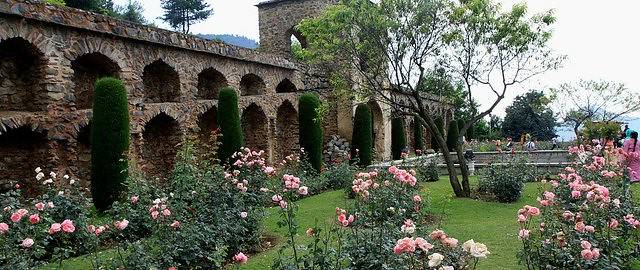
Mughal Gardens & Mosques
Today morning we decided to explore the city in depth. There is so much to see here: the historical old city and its mosques, the17th century Mughal gardens, the British-era museum and the 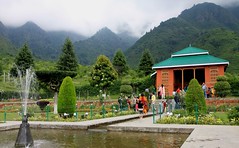 Shiva temple, which is rumored to be from the time of the 9th century BC Pandavas. Although the Mughal gardens were on the top of my list, we decided to start with the old city as it was drizzling outside; not the perfect weather to be in gardens. So we bargained with an auto-rickshaw driver to take us to the 5 landmarks of Srinagar’s old city for Rs.300 and hopped in.
Shiva temple, which is rumored to be from the time of the 9th century BC Pandavas. Although the Mughal gardens were on the top of my list, we decided to start with the old city as it was drizzling outside; not the perfect weather to be in gardens. So we bargained with an auto-rickshaw driver to take us to the 5 landmarks of Srinagar’s old city for Rs.300 and hopped in.
From the Boulevard the auto turned right towards Dal Gate and entered into a completely different world. Here suddenly there were no tourists on the streets; just locals. Almost everybody was attired in the Kashmiri Pherans – long loose gowns hanging down below the knees. The ones worn by women were beautifully embroidered and they wore matching head-scarves. The streets were narrower than the ones in the newer parts of town but there were just as many stores selling everything from daily needs to handicrafts and the ever-popular Kashmiri shawls.
Our first stop of the auto-rickshaw tour was the grand old Pir Dastgir Sahib. It had a traditional white facade with a dark green trim. Sadly, it was built right by the street with no courtyard 
Slightly unnerved by this experience, Madhu and I wondered if the other mosques in Srinagar would be as intense. Our next stop, Rozabal shrine, only added to the situation. It claims that the sarcophagus within its inner sanctum contains the remains of Christ. Some people believe in the theory that when the Lord was crucified, he didn’t really die on the cross. He survived the incident and in his wanderings came to Kashmir, spending the remaining of his life here. The Rozabal (Rose Line) shrine was originally opened to the public for viewing but due to some recent ‘incident’ with a foreign visitor, its doors are now closed. Our auto guy stopped outside the shrine and asked us to take pictures from the outside. But just as we clambered out of the auto and pulled up our cameras, a local man walked out of a neighboring store and very sternly asked us to refrain from taking pictures. His tone and attitude scared us and we immediately got back into the auto, putting our cameras away. By this time, we were ready to head back to good old, less intense Dal Lake.
But it did get better. Our third stop of the day turned things around. The beautiful Naqashband Sahib dedicated to a Sufi saint is set inside a large courtyard. It’s built in a traditional Himachali style of alternating layers of stone and wood. The green gable at the top made it one of the most elegant looking structures we’d seen in Srinagar; it almost looks like a castle. In the courtyard, at the base of a large Chinar tree, hundreds of pigeons flocked to feed on the grains that devotees threw out for them; it was a lovely sight! Unlike Pir Dastgir Sahib, there were just a few visitors around, so we could look around leisurely. It went a long way in soothing our nerves.
dedicated to a Sufi saint is set inside a large courtyard. It’s built in a traditional Himachali style of alternating layers of stone and wood. The green gable at the top made it one of the most elegant looking structures we’d seen in Srinagar; it almost looks like a castle. In the courtyard, at the base of a large Chinar tree, hundreds of pigeons flocked to feed on the grains that devotees threw out for them; it was a lovely sight! Unlike Pir Dastgir Sahib, there were just a few visitors around, so we could look around leisurely. It went a long way in soothing our nerves.
Next was Jama Masjid. We’ve seen the Jama Masjids of many other cities and have found the architecture 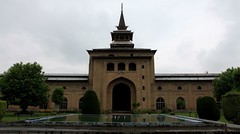 of most of them to be similar. But this one in Srinagar turned out to be both different and more stunning! Instead of the usual domed Mughal architecture, the prayer halls were topped by a slim, conical, 3-layered pinnacle. The interior prayer halls were simple but vast and tall with supporting wooden pillars. The ceiling was typically Kashmiri with walnut wood in a dark finish. The central courtyard was beautifully landscaped with grass and Chinar trees in each of the four corners. Apart from us there were no other visitors, so it was a lovely visit. On our way out, we made a small donation towards the mosque’s funds, for which we promptly received a receipt.
of most of them to be similar. But this one in Srinagar turned out to be both different and more stunning! Instead of the usual domed Mughal architecture, the prayer halls were topped by a slim, conical, 3-layered pinnacle. The interior prayer halls were simple but vast and tall with supporting wooden pillars. The ceiling was typically Kashmiri with walnut wood in a dark finish. The central courtyard was beautifully landscaped with grass and Chinar trees in each of the four corners. Apart from us there were no other visitors, so it was a lovely visit. On our way out, we made a small donation towards the mosque’s funds, for which we promptly received a receipt.
Our last stop in the old city was the grand Khanqah in the Khwaja Bazaar area. It’s an 18th  century building with elaborate wooden carvings and colorful papier-m ¢che reliefs inside. It was built over what was considered to be Srinagar’s first mosque back in the 14th century, built by a Persian saint who is said to have introduced Sufi Islam to Kashmir. We walked around the main courtyard and at the back were accosted by a friendly, elderly Imam who urged us to enter the shrine through a rear entrance and then proceeded to show us around, asking Madhu to take pictures of the important areas. At first we were thrilled with the attention. Then at the end of the tour when he (literally) demanded Rs.100 as donation for the shrine, we were not so thrilled! Once Madhu handed over the note, he asked for some money for himself too. We left the shrine feeling as fleeced as we had when visiting the temples of Mathura & Vrindavan !
century building with elaborate wooden carvings and colorful papier-m ¢che reliefs inside. It was built over what was considered to be Srinagar’s first mosque back in the 14th century, built by a Persian saint who is said to have introduced Sufi Islam to Kashmir. We walked around the main courtyard and at the back were accosted by a friendly, elderly Imam who urged us to enter the shrine through a rear entrance and then proceeded to show us around, asking Madhu to take pictures of the important areas. At first we were thrilled with the attention. Then at the end of the tour when he (literally) demanded Rs.100 as donation for the shrine, we were not so thrilled! Once Madhu handed over the note, he asked for some money for himself too. We left the shrine feeling as fleeced as we had when visiting the temples of Mathura & Vrindavan !
Later we asked the auto-driver to drop us at the fantastic Mughal Darbar on Residency Road for lunch. After a satisfying lunch of Rista (meat balls), Kababs and rice we went to JK Tourism Dept’s Tourist Reception Center (TRC) to get a map of the state and also find details of buses to and from Gulmarg. The staff at the TRC was extremely helpful; we were a little amazed by their warmth and eager-to-help attitude. The complex had relatively clean toilets, which I could use (saved a trip back to the houseboat!) and also a small library that stocked books on Kashmir. Madhu and I browsed through their collection for a while. By this time the rains had subsided considerably so we headed out for some more sight-seeing.
Mughal Gardens
We hired an auto rickshaw to cover the top 4 gardens of Srinagar – Shalimar, Nishat, Cheshmeshahi & Pari Mahal – for a total of Rs.500. All of them lie at the southeastern edge of Dal Lake with Cheshmashahi being the closest and Shalimar being the furthest out from the center. We first headed towards the closest one. En route we passed Srinagar’s pride, the 300-acre golf course called Royal Springs. We also passed a check point where we had to alight from the auto and get ourselves and our bags frisked before being allowed to proceed – they don’t take security lightly in Srinagar. The auto then dropped us off at the foot of the gardens where we bought entrance tickets and then followed a huge rush of tourists into what was probably the prettiest garden we’ve ever set foot in.
We’d read a lot about the grandeur of Srinagar’s Mughal gardens but we never expected it to be as striking.  In fact, since these gardens are about 400 years old, I almost expected a little bit of decay and ruins. On the contrary, Cheshmeshahi looked like it was built yesterday! The flowers were in full bloom, the hedges were beautifully manicured and the grass looked like it was mowed down to a perfect level just that same morning. The misty, green mountains provided a fantastic backdrop like nowhere else. Of course, the main attraction was the ‘Cheshma’ or spring, which spouts in the center of the garden and is considered to have medicinal powers. People played in its waters and splashed it over their faces and limbs in complete excitement; it was amusing to watch. Built over 2 levels, Cheshmeshahi is probably the smallest of the 4 gardens we visited today but it had the most varied array of flowers and plants. A man walked amidst the crowd softly whispering ‘flower seeds’; an unauthorized seller. The beauty of the flowers almost tempted me to buy them for my mother-in-law who is an avid gardener. But the ‘unauthorized’ part of the deal didn’t cut it.
In fact, since these gardens are about 400 years old, I almost expected a little bit of decay and ruins. On the contrary, Cheshmeshahi looked like it was built yesterday! The flowers were in full bloom, the hedges were beautifully manicured and the grass looked like it was mowed down to a perfect level just that same morning. The misty, green mountains provided a fantastic backdrop like nowhere else. Of course, the main attraction was the ‘Cheshma’ or spring, which spouts in the center of the garden and is considered to have medicinal powers. People played in its waters and splashed it over their faces and limbs in complete excitement; it was amusing to watch. Built over 2 levels, Cheshmeshahi is probably the smallest of the 4 gardens we visited today but it had the most varied array of flowers and plants. A man walked amidst the crowd softly whispering ‘flower seeds’; an unauthorized seller. The beauty of the flowers almost tempted me to buy them for my mother-in-law who is an avid gardener. But the ‘unauthorized’ part of the deal didn’t cut it.
Pari Mahal is situated just about 3kms up the hill from Cheshmeshahi. It’s quite a climb, though,  because of which, views from here are the best ever. The garden is built over 6 terraced levels, which in itself was quite amazing. It is definitely not as green or beautiful as Cheshmeshahi but the views make up for that. Moreover, the arched Mughal walls that drape one end of the 3rd level are absolutely magnificent and provide a beautiful backdrop to the rose bushes and apple trees in the foreground. From here, we got a bird’s eye view of Royal Springs, which is probably the prettiest and grandest golf course we’ve seen in India!
because of which, views from here are the best ever. The garden is built over 6 terraced levels, which in itself was quite amazing. It is definitely not as green or beautiful as Cheshmeshahi but the views make up for that. Moreover, the arched Mughal walls that drape one end of the 3rd level are absolutely magnificent and provide a beautiful backdrop to the rose bushes and apple trees in the foreground. From here, we got a bird’s eye view of Royal Springs, which is probably the prettiest and grandest golf course we’ve seen in India!
Our third stop was Shalimar Gardens, which was built by Shah Jehan himself and is considered to be the most famous.  Many Hindi movies of the 60s have been shot here. It is quite impressive with a central channel of water that runs its entire length with grand, Mughal pavilions at every few meters. Fountains line this channel and add to the elegance of the landscape. The water is channeled within the pavilion as well with marble seating over which the Mughals of the past must have spent their idle evenings. The water surrounds the pavilions like a moat and within this hundreds of fountains have been placed. When we visited, most of the fountains on the vertical channel were functioning while the ones that surrounded the pavilions were defunct. I can only imagine what it must look and feel like had they all been functioning! On either side of the water channel were grassy lawns punctuated with large Chinar trees that provided ample shaded spots for picnicking families. I was envious of Srinagar’s residents for having such a wonderful place to spend an evening with family and friends.
Many Hindi movies of the 60s have been shot here. It is quite impressive with a central channel of water that runs its entire length with grand, Mughal pavilions at every few meters. Fountains line this channel and add to the elegance of the landscape. The water is channeled within the pavilion as well with marble seating over which the Mughals of the past must have spent their idle evenings. The water surrounds the pavilions like a moat and within this hundreds of fountains have been placed. When we visited, most of the fountains on the vertical channel were functioning while the ones that surrounded the pavilions were defunct. I can only imagine what it must look and feel like had they all been functioning! On either side of the water channel were grassy lawns punctuated with large Chinar trees that provided ample shaded spots for picnicking families. I was envious of Srinagar’s residents for having such a wonderful place to spend an evening with family and friends.
Nishat Gardens is right by the southern bank of Dal Lake and could be visited by a Shikara ride as well. 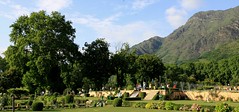 The road that separates the garden from the lake is dotted with dhabhas and stores and is quite chaotic; not a pretty sight. But all that changed the minute we set foot in the garden! At the entrance, though, we encountered a unique concept. All visitors and their luggage were checked to see if anyone was carrying plastic bottles. If yes, like I was, then we were asked to pay Rs.10 as a deposit, per plastic item, for which a receipt was issued. On exiting the garden, if the plastic bottle was still found on the person, then Rs.10 would be refunded against the receipt. This was to ensure that people don’t leave behind their plastic litter in the garden! We were impressed! Of course, Rs.10 is a very small amount but I think, what this does is, makes our people aware of their actions. Most Indian visitors are notorious for dropping their plastic litter right where they are standing without a second thought to what it does to our streets and environment.
The road that separates the garden from the lake is dotted with dhabhas and stores and is quite chaotic; not a pretty sight. But all that changed the minute we set foot in the garden! At the entrance, though, we encountered a unique concept. All visitors and their luggage were checked to see if anyone was carrying plastic bottles. If yes, like I was, then we were asked to pay Rs.10 as a deposit, per plastic item, for which a receipt was issued. On exiting the garden, if the plastic bottle was still found on the person, then Rs.10 would be refunded against the receipt. This was to ensure that people don’t leave behind their plastic litter in the garden! We were impressed! Of course, Rs.10 is a very small amount but I think, what this does is, makes our people aware of their actions. Most Indian visitors are notorious for dropping their plastic litter right where they are standing without a second thought to what it does to our streets and environment.
The terraced lawns provide a lovely view of the Dal Lake. 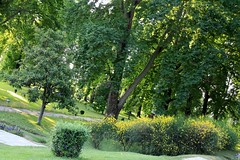 Here, too, there is a central channel of water that runs the entire length of the garden with stone platforms at the end of each terraced level. There were fountains as well but none were functioning at that time. A small shack-restaurant, run by JKTDC, in a corner of the garden provided an excellent place to sit and sip Kashmiri Kahwa while gazing at the lush greenery around; it was a lovely setting! The topmost level of the garden is still being restored (or reconstructed?) by the Archaeological Survey of India. It was closed to the public but we could peek in to see a large pavilion which marked the end of the garden; from there the views out to Dal Lake would be incomparable!
Here, too, there is a central channel of water that runs the entire length of the garden with stone platforms at the end of each terraced level. There were fountains as well but none were functioning at that time. A small shack-restaurant, run by JKTDC, in a corner of the garden provided an excellent place to sit and sip Kashmiri Kahwa while gazing at the lush greenery around; it was a lovely setting! The topmost level of the garden is still being restored (or reconstructed?) by the Archaeological Survey of India. It was closed to the public but we could peek in to see a large pavilion which marked the end of the garden; from there the views out to Dal Lake would be incomparable!
By the time we got dropped off near our houseboat it was 7pm. We had had a long day of sightseeing but it had given us a strong sense of Srinagar’s glorious religious and historic past. There’s still more to see of this lovely city but that’ll have to wait for another day. Tomorrow we will head out to visit Gulmarg, our first destination in the surrounding hills of Kashmir valley.


i have found that entering mosques as a non muslim is a rare occurance around the world – which is kind of sad since they are gorgeous! I understand preserving the sacred site for its purpose – worship, but still, i would love to take a peak into them!
Hi Nithya,
Good to hear from you …
In the past 2 years, Rozabal was the only place where we were not allowed to go in / click pictures. There is anyway a lot of controversies around the shrine.
I guess it is best to stay away …
… Jama Masjid was lovely – one can spend hours there …
Which part of the world are you passing through … ?
Cheers,
Madhu
Reminds me of my sojourn in that city 🙂